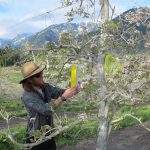Written by Christopher Strohm, WSU Extension. September, 2018
As part of a Pear IPM project we are tracking natural enemies in pear orchards and we wanted to share who is active now with you. As you manage your blocks this year, consider your natural enemies and what they can do for you. Below is a description of Green lacewings who are abundant throughout the summer in Central Washington Pear Orchards.
Green lacewings in Wenatchee Valley Pear Orchards
Volatile lures can be constructed that separately attract each lacewing species. In 2017 and 2018, adults were active early, coming to lured sticky card traps in late March and early April. The highest adult abundance occurred in June, July, and August. Adults were detected on traps in orchards using conventional, IPM, or organic management. Larvae are more difficult to find and require beat tray sampling. In 2017 they were most common in organic pear blocks from late July to October. To see what populations are looking like currently visit https://treefruit.wsu.edu/crop-protection/pear-ipm/pear-ipm-scouting/
Identification
There are two common green lacewing species in North Central Washington orchards. Adults of both species tend to be bright green with four large, lace-like wings. They are 10-20 mm in length. Chrysoperla plorabunda has a notable pale white streak on its neck and back (Photo 1). Chrysopa nigricornis lacks this streak and tends to be larger than C. plorabunda (Photo 2). Note that overwintering adults, the first generation seen, may have a brown coloration instead of green.
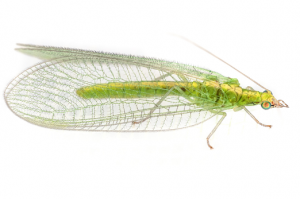
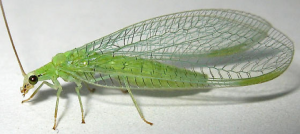
Lacewing larvae can be described as having an ‘alligator-like’ appearance. Larvae have an elongate body between 1-15mm and are often covered in hairs. Larval mouthparts are usually larger than the head (Photo 3). Lacewing eggs are small (about 0.5mm) and are attached to surfaces with a stalk that is several millimeters long (Photo 4).
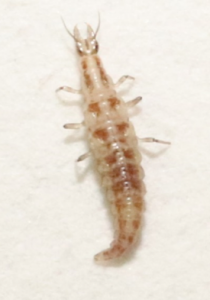
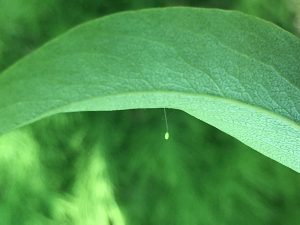
Biology
Adults of C. nigricornis are predators but most lacewing adults are nectar, pollen, and honeydew feeders. All larvae are voracious predators, feeding on pests such as aphids, pear psylla, and spider mites. ‘Aphid lion’ is an old common name for lacewing larva due to the affinity of some species for aphid prey.
Green lacewings overwinter as a pupae or adults. In spring, adults emerge, disperse, and mate. Female lacewings will lay stalked eggs on plant surfaces. These eggs can be laid singly or in groups. The stalks may prevent cannibalization of the group by the earliest hatchlings. The long sickle-like mouthparts of the larvae are hollow, allowing them to pierce the bodies of their prey and suck out their innards. Larvae develop through 5 instars before pupation. Both species have 3-4 generations per season in the pacific northwest (Gut, 1993).
Additional Information:
https://treefruit.wsu.edu/crop-protection/opm/
https://treefruit.wsu.edu/crop-protection/pear-ipm/.
Acknowledgements
This project was funded in part by a grant from WSDA Specialty Crop Block Grant K1986.
Contacts
Extension Assistant, Pear IPM
WSU Tree Fruit Research and Extension Center
509-663-8181 ext. 233
Fruit Matters articles may only be republished with prior author permission © Washington State University. Reprint articles with permission must include: Originally published by Washington State Tree Fruit Extension Fruit Matters at treefruit.wsu.edu and a link to the original article.
